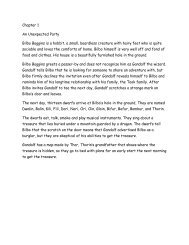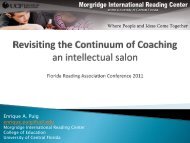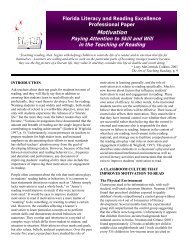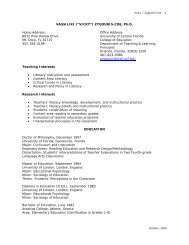compliance statement
compliance statement
compliance statement
You also want an ePaper? Increase the reach of your titles
YUMPU automatically turns print PDFs into web optimized ePapers that Google loves.
During reading, poor readers may have difficulty decoding, and so have difficulty<br />
reading the words of their texts accurately. In addition, some poor readers read<br />
too slowly, or lack fluency. As a result of their slow, labored reading, they often do<br />
not comprehend much of what they read, and the attention they have to give to<br />
figuring out the words keeps them from understanding the text’s message. 14<br />
All too often poor readers lack sufficient background knowledge about the<br />
topic of a text. They may have trouble connecting the ideas of a text. They<br />
often are not familiar with the vocabulary they encounter, and have trouble<br />
determining word meanings. Further, even when poor readers possess relevant<br />
background knowledge, they frequently are not able to activate it to help them<br />
understand what they read.<br />
Some poor readers also are unaware of text organization. They do not<br />
know enough about the organizational structure of narratives or the various<br />
organizational structures of expository texts to help them read and understand.<br />
After reading, poor readers typically do not think about or reflect upon what<br />
they have read. They almost never seek out additional information about a topic.<br />
The cumulative effect of these difficulties is that poor readers often lose<br />
confidence in their ability to read. Because reading is difficult for them, poor<br />
readers cannot and do not read widely. As a result, they are exposed to much less<br />
text than are good readers and so receive much less practice reading. Further, the<br />
practice they do receive is often frustrating, because many of the texts they are<br />
asked to read are too difficult for them. 15<br />
The question then is: How can classroom reading instruction help poor<br />
readers—indeed, all students—become more like good readers? Research suggests<br />
that the answer may lie in providing students with instruction that both teaches<br />
them the comprehension strategies that work so well for good readers and helps<br />
them to develop the necessary metacognitive awareness of how and when to use<br />
these strategies.<br />
14 Adams, M. J. (1990). Beginning to read: Thinking and learning about print. Cambridge MA: MIT Press.<br />
15 Cunningham, A. E., & Stanovich, K. E. (1998). What reading does for the mind. American Educator, 22, 8–15.<br />
8<br />
Comprehension<br />
Instruction







